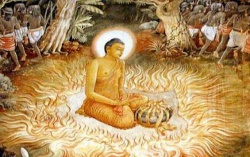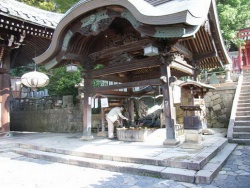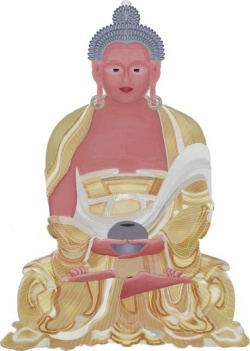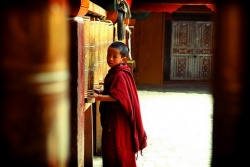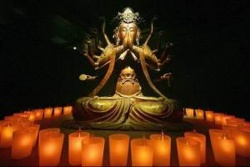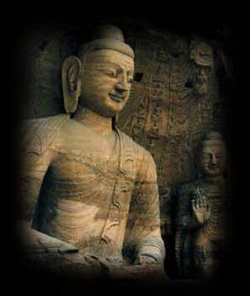Difference between revisions of "The Kalachakra Initiation Explained"
| (3 intermediate revisions by 2 users not shown) | |||
| Line 1: | Line 1: | ||
{{DisplayImages|180|784|1647|403|239|1179}} | {{DisplayImages|180|784|1647|403|239|1179}} | ||
| + | |||
| + | |||
| + | |||
| + | |||
| + | |||
| + | |||
| + | |||
<poem> | <poem> | ||
| − | The [[Kalachakra]] [[Initiation]] is generally given over 12 days. First, there are eight days of preparation [[rituals]], during which the [[monks]] make the [[mandala]]. Then the students are initiated, after which they are allowed to see the completed [[sand mandala]]. The {{Wiki|ceremony}} ends when the [[monks]] release the positive [[energy]] of the [[mandala]] into the everyday [[world]] through a final [[ritual]]. | + | The [[Kalachakra]] [[Initiation]] is generally given over 12 days. First, there are eight days of preparation [[rituals]], during which the [[monks]] make the [[mandala]]. Then the students are [[initiated]], after which they are allowed to see the completed [[sand mandala]]. The {{Wiki|ceremony}} ends when the [[monks]] [[release]] the positive [[energy]] of the [[mandala]] into the everyday [[world]] through a final [[ritual]]. |
| + | |||
| + | The [[Tibetan]] [[word]] for [[initiation]] is wong-khor, which literally means giving permission, or granting the authority to practice the [[Tantra]]. The [[person]] conferring the [[initiation]] is known as the [[ritual]] [[master]] or [[Vajra Master]], because the [[vajra]] is the [[ritual]] implement that cuts | ||
| + | |||
| + | through [[illusion]] and represents the [[indestructible]] [[mind]]. Since the [[tantra]] itself [[lives]] through [[direct transmission]] by the [[Vajra Master]], the [[initiation]] fulfils the [[Vajra]] [[Master's]] pledge to pass on the [[tantra]] without diminishing it in any way, always for the [[benefit]] of all [[sentient beings]]. | ||
| + | |||
| + | During the [[initiation]], the [[student]] makes a similar pledge to [[respect]] and uphold the teachings. In this way the [[student]] enters into the [[lineage]]. Students may choose to take on different levels of commitment. One who maintains the commitment to a [[conscientious]] daily practice will achieve greater results, and the [[lineage]] will be strengthened. Or, the [[initiation]] may be received simply as a [[blessing]]. | ||
| + | |||
| + | The [[student]], by generating himself (or herself) as the [[deity]], is introduced to new [[mental]] patterns which help him to abandon old, {{Wiki|destructive}} {{Wiki|conditioning}}, thus bringing him closer to the [[experience]] of the [[bliss]] [[consciousness]] of [[Kalachakra]]. | ||
| + | |||
| + | Many beautiful [[objects]] are used in the [[Kalachakra]] [[rituals]]. The thekpu is the special house where the [[mandala]] is built. There is a brocade [[throne]] where the [[Vajra Master]], in this case [[His Holiness the Dalai Lama]], sits to give the [[initiation]] and the [[altar]] to the [[Kalachakra]] | ||
| + | |||
| + | [[deity]] contains elaborate [[offerings]] and [[ritual]] [[objects]]. Large {{Wiki|silk}} tapestries of the [[Buddha]], [[Kalachakra]], and various [[protector]] [[deities]] are hung around the thekpu, the [[throne]], and the [[altar]]. | ||
| + | |||
| + | |||
| + | |||
| + | On the first day of the {{Wiki|ceremony}}, a representative of the students requests that the [[Vajra Master]] give the [[initiation]], and he consents, showing his [[great compassion]] for his students. Next the [[Vajra Master]] asks the local [[spirits]] for permission to use their home. Usually the [[spirits]] at | ||
| + | |||
| + | first do not want to cooperate so to appease them, the assisting [[monks]] perform the [[Dance]] of the [[Earth]], making [[symbolic]] gestures with their hands and feet. The [[prayers]], {{Wiki|music}} and [[dance]] subdue all interfering [[spirits]]. | ||
| + | |||
| + | After the [[dance]], the [[Dalai Lama]] receives permission to proceed with the {{Wiki|ceremony}} from [[Tenma]], the [[earth spirit]], on behalf of all the local [[spirits]]. The [[mandala]] will house many of the thousands of [[deities]] found in [[Tibetan Buddhism]] during the {{Wiki|ceremony}}. [[Symbolic]] daggers are | ||
| + | |||
| + | now placed around the [[mandala]] site to {{Wiki|protect}} it. All the [[objects]] to be used in the many [[rituals]] must be blessed by the [[Dalai Lama]], [[including]] the string that is used to draw the [[mandala]] and the coloured sands. | ||
| − | + | To begin the drawing, the {{Wiki|ceremonial}} string is dipped into liquid white chalk. Holding one end taut, while an assistant holds the other end, the [[Vajra Master]] plucks the string, and the chalk falls onto the platform to make the first lines of the [[sand mandala]]. Each [[time]] the [[Vajra Master]] plucks the | |
| − | + | string, the snap {{Wiki|sounds}} a [[blessing]] from the [[Buddha]] for the construction of the [[sand mandala]]. It takes two days for all the lines to be drawn, the [[mandala]] design at this stage looks like an enormous blueprint, seven feet in {{Wiki|diameter}}. | |
| − | |||
| − | + | On the third day, [[water]] mixed with a special spice, {{Wiki|saffron}}, is scattered on the lines of the [[mandala]]; with it, the [[Vajra Master]] rubs out certain lines on the [[mandala]] blueprint, opening the entrance ways for the 722 [[deities]] who will reside in the [[mandala]] during the {{Wiki|ceremony}}. In | |
| − | + | order to enter our [[world]], they need a clean and [[pure]] place to stay. Grains of {{Wiki|wheat}} are also placed on the [[mandala]] at this [[time]], representing cushions where the [[gods]] and [[goddesses]] are invited to sit. | |
| − | + | Making three parallel lines, the [[Dalai Lama]] then puts the first grains of [[red]], white, and black sand near the centre of the [[mandala]]. These three lines represent the [[body]], [[speech]] and [[mind]] of the [[Buddha]]. Then the [[monks]] continue to apply the sand. Just memorising the hundreds of [[symbols]] in | |
| − | |||
| − | + | the [[Kalachakra mandala]] design and [[learning]] how to apply the sand takes at least two years of intense study. Starting in the middle and working outward, they use a long serrated funnel called a chakpu to create the detailed designs. When two chakpus are rasped together, the coloured sand flows out evenly and smoothly in a thin {{Wiki|stream}} onto the [[mandala]]. A wooden scraper called a [[shinga]] is used to straighten the lines and to fix any errors. | |
| − | + | When the [[mandala]] is finally completed [[sacred]] vases are placed around it. The sides of the thekpu are covered with curtains so that the [[mandala]] will not be seen before the proper [[time]]. The [[Dalai Lama]] thanks the [[spirits]] and [[deities]] for their cooperation by making [[offerings]] to them. The | |
| − | + | [[monks]] play [[sacred]] {{Wiki|music}} with [[bells]], gongs, [[drums]], and huge twelve foot horns. They also do a [[dance]] of celebration that lasts an hour and a half. | |
| + | |||
| + | On the ninth day, after the [[Dalai Lama]] and the [[monks]] finish their morning [[prayers]] and [[meditation]], the students arrive for the first [[time]]. Those who wish to be [[initiated]] into the practice of the [[Kalachakra]] teachings take a [[vow]] to have [[compassion]] toward all living things, to work for the [[benefit]] of others, and never to reveal the secrets of the [[mandala]]. | ||
| − | |||
The students are each given two stalks of [[kusha grass]], because the [[Buddha]] was sitting on [[kusha grass]] under the [[Bodhi tree]] when he became [[enlightened]]. The students are told to put the long stalks of [[kusha grass]] under their mattresses and the short stalk under their pillows. This will help the students to remember and study their [[dreams]] that night. | The students are each given two stalks of [[kusha grass]], because the [[Buddha]] was sitting on [[kusha grass]] under the [[Bodhi tree]] when he became [[enlightened]]. The students are told to put the long stalks of [[kusha grass]] under their mattresses and the short stalk under their pillows. This will help the students to remember and study their [[dreams]] that night. | ||
| − | |||
| − | Next, the [[Vajra Master]] gives the students what are called the Seven Childhood [[Initiations]]. These [[initiations]] will help students to be [[reborn]] during the {{Wiki|ceremony}} as {{Wiki|ideal}} persons fit to enter the perfect [[world]] of the [[mandala]]. Each [[initiation]] corresponds to a significant event in the [[life]] of a child. The seven [[initiations]] represent a child's receiving a [[name]], having a first bath, getting a first haircut, first experiencing the [[five senses]], getting pierced {{Wiki|ears}}, saying a first [[word]], and [[learning]] to read. | + | The next day after some preliminaries, the actual [[initiation]] begins. After the students have made pledges of good {{Wiki|behaviour}}, the [[Dalai Lama]] asks [[Kalachakra]] to open their [[eyes]]. Each [[student]] has received a [[red]] blindfold to place over his or her {{Wiki|forehead}} as a [[symbol]], since the |
| + | |||
| + | students are not yet [[spiritually]] ready to see the [[sand mandala]], and they now remove their blindfolds, [[symbolically]] removing the {{Wiki|darkness}} of [[ignorance]]. They are now prepared to 'see' the [[mandala]]. | ||
| + | |||
| + | Next, the [[Vajra Master]] gives the students what are called the Seven Childhood [[Initiations]]. These [[initiations]] will help students to be [[reborn]] during the {{Wiki|ceremony}} as {{Wiki|ideal}} persons fit to enter the {{Wiki|perfect}} [[world]] of the [[mandala]]. Each [[initiation]] corresponds to a | ||
| + | |||
| + | |||
| + | significant event in the [[life]] of a child. The seven [[initiations]] represent a child's receiving a [[name]], having a first bath, getting a first haircut, first experiencing the [[five senses]], getting pierced {{Wiki|ears}}, saying a first [[word]], and [[learning]] to read. | ||
| + | |||
| + | |||
| + | After the students have been '[[reborn]]' by completing the childhood [[initiations]], they may enter the {{Wiki|ideal}} [[world]] of the [[Wheel of Time]] - the [[universe]] of [[enlightenment]], ruled by the [[deity]] [[Kalachakra]]. They can now [[view]] the [[mandala]]. The [[Kalachakra]] [[sand mandala]] shows the | ||
| + | |||
| + | 722 [[gods]] and [[goddesses]] as well as the palace in which they dwell. The four faces of the [[deity]] named [[Kalachakra]] are also pictured. To represent | ||
| + | |||
| + | his faces in the [[mandala]] four wedge-shaped areas of {{Wiki|colour}} are used, within the circle. A blue-black wedge, or face, at the bottom of the picture looks [[east]]. The [[red]] face looks [[south]]. The white face looks [[north]]. The orange or [[yellow]] face at the top looks [[west]]. | ||
| + | |||
| + | |||
| + | If you envision what the [[mandala]] looks like from the [[deity's]] point of [[view]], inside the [[mandala]] at its center, the [[deity's]] [[black face]] looks forward, his [[red]] face looks to his right, his white face looks to his left, and his [[yellow]] face looks backward. There are {{Wiki|representations}} in the | ||
| + | |||
| + | [[mandala]] of 721 additional [[deities]], as well as [[animals]], [[flowers]], and [[jewels]]. The palace of [[Kalachakra]], where the [[gods]] and [[goddesses]] [[live]], is the largest square within the circle. This building has five levels, and each level consists of a square with four walls. In the | ||
| + | |||
| + | middle of each wall is an entrance. In order to reach the most secret central chambers of the palace, [[initiates]] must travel through the maze of squares. Each square represents a different aspect of an [[enlightened being]]. | ||
| + | |||
| + | |||
| − | + | The [[mandala]] appears to be flat, but you can use your [[imagination]] to picture it [[rising up]] three-dimensionally toward its [[lotus-flower]] center. To trace the [[path]] of [[enlightenment]], you enter the black eastern doorway from the outside of the building. You will find yourself on the first level of the palace. This level is called the [[mandala]] of the [[enlightened body]]. Halfway inside the [[body]] [[mandala]] is another set of four walls and an entrance. | |
| − | + | When you proceed through the entrance, you have reached the [[enlightened speech]] [[mandala]]. Halfway inside, there is another set of walls and entrances where you will discover an even higher level called the [[enlightened mind]] [[mandala]]. Halfway inside the [[mind]] [[mandala]] is a square platform that represents the [[enlightened]] [[wisdom]] [[mandala]]. | |
| − | |||
Once in the [[wisdom]] [[mandala]], you will find another square platform. This is the [[highest]] level of the palace, the [[enlightened]] great [[bliss]] [[mandala]]. Within it is the [[eight-petalled lotus]], at the centre of which stands the [[deity]] [[Kalachakra]] embracing his {{Wiki|female}} counterpart, [[Vishvamata]], the All-Mother. Together they symbolise full [[enlightenment]], the union of [[wisdom]] and [[compassion]]. | Once in the [[wisdom]] [[mandala]], you will find another square platform. This is the [[highest]] level of the palace, the [[enlightened]] great [[bliss]] [[mandala]]. Within it is the [[eight-petalled lotus]], at the centre of which stands the [[deity]] [[Kalachakra]] embracing his {{Wiki|female}} counterpart, [[Vishvamata]], the All-Mother. Together they symbolise full [[enlightenment]], the union of [[wisdom]] and [[compassion]]. | ||
| − | |||
| − | In the last part of the {{Wiki|ceremony}}, the [[Dalai Lama]] says [[prayers]], thanking the 722 [[deities]] for their participation and requesting them to leave the [[mandala]] and return to their [[sacred]] homes. He removes the sand that [[symbolically]] represents the [[deities]], then cuts through the [[mandala]] along its original wheel-shaped lines with a [[ritual]] implement. The sand is brushed toward the centre of the platform and then the [[monks]] put it into urns and transport it to a nearby [[body]] of [[water]]. With [[chanting]] and more [[prayers]], a [[ritual]] assistant empties the sand into the [[water]], and the perfect [[peace]] of [[Kalachakra]] flows with it into the everyday [[world]]. The [[mandala]], now gone from [[view]], remains forever in the [[memory]] of all who entered its perfect [[realm]]. | + | Throughout the [[mandala]] there are many other identifiable [[symbols]]. [[Twelve animals]], located on the lowest level of the palace, are associated with the twelve months of the year. Each [[animal]] supports a [[lotus flower]] where thirty [[deities]] are represented, symbolising the thirty days of the month. And |
| + | |||
| + | around the entire palace lie circular bands representing the {{Wiki|ancient}} [[elements]]: [[yellow]] for [[earth]], a white band with waves representing [[water]], salmon [[red]] for [[fire]], gray for [[wind]], and finally the outermost band, representing [[space]] and [[consciousness]]. With the [[Vajra Master]] guiding their | ||
| + | |||
| + | [[minds]] and inner [[eyes]], the students become authorised to enter into this {{Wiki|perfect}} palace. But to become [[enlightened]], the students will first have to work hard to {{Wiki|perfect}} their [[techniques]] of [[meditation]] and their [[compassion]] toward all [[living beings]]. | ||
| + | |||
| + | |||
| + | In the last part of the {{Wiki|ceremony}}, the [[Dalai Lama]] says [[prayers]], thanking the 722 [[deities]] for their participation and requesting them to leave the [[mandala]] and return to their [[sacred]] homes. He removes the sand that [[symbolically]] represents the [[deities]], then cuts through the [[mandala]] | ||
| + | |||
| + | along its original wheel-shaped lines with a [[ritual]] implement. The sand is brushed toward the centre of the platform and then the [[monks]] put it into urns and transport it to a nearby [[body]] of [[water]]. With [[chanting]] and more [[prayers]], a [[ritual]] assistant empties the sand into the [[water]], and the | ||
| + | |||
| + | {{Wiki|perfect}} [[peace]] of [[Kalachakra]] flows with it into the everyday [[world]]. The [[mandala]], now gone from [[view]], remains forever in the [[memory]] of all who entered its {{Wiki|perfect}} [[realm]]. | ||
| + | |||
| + | |||
| + | |||
| + | Though the [[philosophy]] of the [[Kalachakra]] is at the [[highest]] level of [[Buddhism]] anyone can use it at any [[time]]. This [[philosophy]] [[urges]] us to reach a splendid, [[pure]] [[inner world]] while still living in our imperfect, [[earthly]] one, using [[Kalachakra]] as a model. For example, a [[pure]] | ||
| + | |||
| + | [[body]] comes from healthy eating and not [[smoking]], drinking [[alcohol]], or taking [[drugs]]. [[Pure]] [[speech]] means not gossiping or saying unkind things about others. A [[pure mind]] is trained away from [[angry]], hateful and [[selfish]] [[thoughts]]. Once each of us purifies our [[body]], [[speech]] and | ||
| + | |||
| + | [[mind]], we can find inner [[peace]]. When we have inner [[peace]], at last it is possible to [[experience]] the [[state of bliss]], or {{Wiki|perfect}} [[happiness]]. | ||
| + | |||
| − | |||
Sources: | Sources: | ||
| + | |||
| + | |||
The [[Wheel of Time]] [[Sand Mandala]]: [[Visual]] [[Scripture]] of [[Tibetan Buddhism]] | The [[Wheel of Time]] [[Sand Mandala]]: [[Visual]] [[Scripture]] of [[Tibetan Buddhism]] | ||
by Barry Bryant, HarperCollins; | by Barry Bryant, HarperCollins; | ||
Latest revision as of 05:44, 6 September 2024
The Kalachakra Initiation is generally given over 12 days. First, there are eight days of preparation rituals, during which the monks make the mandala. Then the students are initiated, after which they are allowed to see the completed sand mandala. The ceremony ends when the monks release the positive energy of the mandala into the everyday world through a final ritual.
The Tibetan word for initiation is wong-khor, which literally means giving permission, or granting the authority to practice the Tantra. The person conferring the initiation is known as the ritual master or Vajra Master, because the vajra is the ritual implement that cuts
through illusion and represents the indestructible mind. Since the tantra itself lives through direct transmission by the Vajra Master, the initiation fulfils the Vajra Master's pledge to pass on the tantra without diminishing it in any way, always for the benefit of all sentient beings.
During the initiation, the student makes a similar pledge to respect and uphold the teachings. In this way the student enters into the lineage. Students may choose to take on different levels of commitment. One who maintains the commitment to a conscientious daily practice will achieve greater results, and the lineage will be strengthened. Or, the initiation may be received simply as a blessing.
The student, by generating himself (or herself) as the deity, is introduced to new mental patterns which help him to abandon old, destructive conditioning, thus bringing him closer to the experience of the bliss consciousness of Kalachakra.
Many beautiful objects are used in the Kalachakra rituals. The thekpu is the special house where the mandala is built. There is a brocade throne where the Vajra Master, in this case His Holiness the Dalai Lama, sits to give the initiation and the altar to the Kalachakra
deity contains elaborate offerings and ritual objects. Large silk tapestries of the Buddha, Kalachakra, and various protector deities are hung around the thekpu, the throne, and the altar.
On the first day of the ceremony, a representative of the students requests that the Vajra Master give the initiation, and he consents, showing his great compassion for his students. Next the Vajra Master asks the local spirits for permission to use their home. Usually the spirits at
first do not want to cooperate so to appease them, the assisting monks perform the Dance of the Earth, making symbolic gestures with their hands and feet. The prayers, music and dance subdue all interfering spirits.
After the dance, the Dalai Lama receives permission to proceed with the ceremony from Tenma, the earth spirit, on behalf of all the local spirits. The mandala will house many of the thousands of deities found in Tibetan Buddhism during the ceremony. Symbolic daggers are
now placed around the mandala site to protect it. All the objects to be used in the many rituals must be blessed by the Dalai Lama, including the string that is used to draw the mandala and the coloured sands.
To begin the drawing, the ceremonial string is dipped into liquid white chalk. Holding one end taut, while an assistant holds the other end, the Vajra Master plucks the string, and the chalk falls onto the platform to make the first lines of the sand mandala. Each time the Vajra Master plucks the
string, the snap sounds a blessing from the Buddha for the construction of the sand mandala. It takes two days for all the lines to be drawn, the mandala design at this stage looks like an enormous blueprint, seven feet in diameter.
On the third day, water mixed with a special spice, saffron, is scattered on the lines of the mandala; with it, the Vajra Master rubs out certain lines on the mandala blueprint, opening the entrance ways for the 722 deities who will reside in the mandala during the ceremony. In
order to enter our world, they need a clean and pure place to stay. Grains of wheat are also placed on the mandala at this time, representing cushions where the gods and goddesses are invited to sit.
Making three parallel lines, the Dalai Lama then puts the first grains of red, white, and black sand near the centre of the mandala. These three lines represent the body, speech and mind of the Buddha. Then the monks continue to apply the sand. Just memorising the hundreds of symbols in
the Kalachakra mandala design and learning how to apply the sand takes at least two years of intense study. Starting in the middle and working outward, they use a long serrated funnel called a chakpu to create the detailed designs. When two chakpus are rasped together, the coloured sand flows out evenly and smoothly in a thin stream onto the mandala. A wooden scraper called a shinga is used to straighten the lines and to fix any errors.
When the mandala is finally completed sacred vases are placed around it. The sides of the thekpu are covered with curtains so that the mandala will not be seen before the proper time. The Dalai Lama thanks the spirits and deities for their cooperation by making offerings to them. The
monks play sacred music with bells, gongs, drums, and huge twelve foot horns. They also do a dance of celebration that lasts an hour and a half.
On the ninth day, after the Dalai Lama and the monks finish their morning prayers and meditation, the students arrive for the first time. Those who wish to be initiated into the practice of the Kalachakra teachings take a vow to have compassion toward all living things, to work for the benefit of others, and never to reveal the secrets of the mandala.
The students are each given two stalks of kusha grass, because the Buddha was sitting on kusha grass under the Bodhi tree when he became enlightened. The students are told to put the long stalks of kusha grass under their mattresses and the short stalk under their pillows. This will help the students to remember and study their dreams that night.
The next day after some preliminaries, the actual initiation begins. After the students have made pledges of good behaviour, the Dalai Lama asks Kalachakra to open their eyes. Each student has received a red blindfold to place over his or her forehead as a symbol, since the
students are not yet spiritually ready to see the sand mandala, and they now remove their blindfolds, symbolically removing the darkness of ignorance. They are now prepared to 'see' the mandala.
Next, the Vajra Master gives the students what are called the Seven Childhood Initiations. These initiations will help students to be reborn during the ceremony as ideal persons fit to enter the perfect world of the mandala. Each initiation corresponds to a
significant event in the life of a child. The seven initiations represent a child's receiving a name, having a first bath, getting a first haircut, first experiencing the five senses, getting pierced ears, saying a first word, and learning to read.
After the students have been 'reborn' by completing the childhood initiations, they may enter the ideal world of the Wheel of Time - the universe of enlightenment, ruled by the deity Kalachakra. They can now view the mandala. The Kalachakra sand mandala shows the
722 gods and goddesses as well as the palace in which they dwell. The four faces of the deity named Kalachakra are also pictured. To represent
his faces in the mandala four wedge-shaped areas of colour are used, within the circle. A blue-black wedge, or face, at the bottom of the picture looks east. The red face looks south. The white face looks north. The orange or yellow face at the top looks west.
If you envision what the mandala looks like from the deity's point of view, inside the mandala at its center, the deity's black face looks forward, his red face looks to his right, his white face looks to his left, and his yellow face looks backward. There are representations in the
mandala of 721 additional deities, as well as animals, flowers, and jewels. The palace of Kalachakra, where the gods and goddesses live, is the largest square within the circle. This building has five levels, and each level consists of a square with four walls. In the
middle of each wall is an entrance. In order to reach the most secret central chambers of the palace, initiates must travel through the maze of squares. Each square represents a different aspect of an enlightened being.
The mandala appears to be flat, but you can use your imagination to picture it rising up three-dimensionally toward its lotus-flower center. To trace the path of enlightenment, you enter the black eastern doorway from the outside of the building. You will find yourself on the first level of the palace. This level is called the mandala of the enlightened body. Halfway inside the body mandala is another set of four walls and an entrance.
When you proceed through the entrance, you have reached the enlightened speech mandala. Halfway inside, there is another set of walls and entrances where you will discover an even higher level called the enlightened mind mandala. Halfway inside the mind mandala is a square platform that represents the enlightened wisdom mandala.
Once in the wisdom mandala, you will find another square platform. This is the highest level of the palace, the enlightened great bliss mandala. Within it is the eight-petalled lotus, at the centre of which stands the deity Kalachakra embracing his female counterpart, Vishvamata, the All-Mother. Together they symbolise full enlightenment, the union of wisdom and compassion.
Throughout the mandala there are many other identifiable symbols. Twelve animals, located on the lowest level of the palace, are associated with the twelve months of the year. Each animal supports a lotus flower where thirty deities are represented, symbolising the thirty days of the month. And
around the entire palace lie circular bands representing the ancient elements: yellow for earth, a white band with waves representing water, salmon red for fire, gray for wind, and finally the outermost band, representing space and consciousness. With the Vajra Master guiding their
minds and inner eyes, the students become authorised to enter into this perfect palace. But to become enlightened, the students will first have to work hard to perfect their techniques of meditation and their compassion toward all living beings.
In the last part of the ceremony, the Dalai Lama says prayers, thanking the 722 deities for their participation and requesting them to leave the mandala and return to their sacred homes. He removes the sand that symbolically represents the deities, then cuts through the mandala
along its original wheel-shaped lines with a ritual implement. The sand is brushed toward the centre of the platform and then the monks put it into urns and transport it to a nearby body of water. With chanting and more prayers, a ritual assistant empties the sand into the water, and the
perfect peace of Kalachakra flows with it into the everyday world. The mandala, now gone from view, remains forever in the memory of all who entered its perfect realm.
Though the philosophy of the Kalachakra is at the highest level of Buddhism anyone can use it at any time. This philosophy urges us to reach a splendid, pure inner world while still living in our imperfect, earthly one, using Kalachakra as a model. For example, a pure
body comes from healthy eating and not smoking, drinking alcohol, or taking drugs. Pure speech means not gossiping or saying unkind things about others. A pure mind is trained away from angry, hateful and selfish thoughts. Once each of us purifies our body, speech and
mind, we can find inner peace. When we have inner peace, at last it is possible to experience the state of bliss, or perfect happiness.
Sources:
The Wheel of Time Sand Mandala: Visual Scripture of Tibetan Buddhism
by Barry Bryant, HarperCollins;
Learning from the Dalai Lama: Secrets of the Wheel of Time
by Karen Pandell with Barry Bryant, Dutton.
